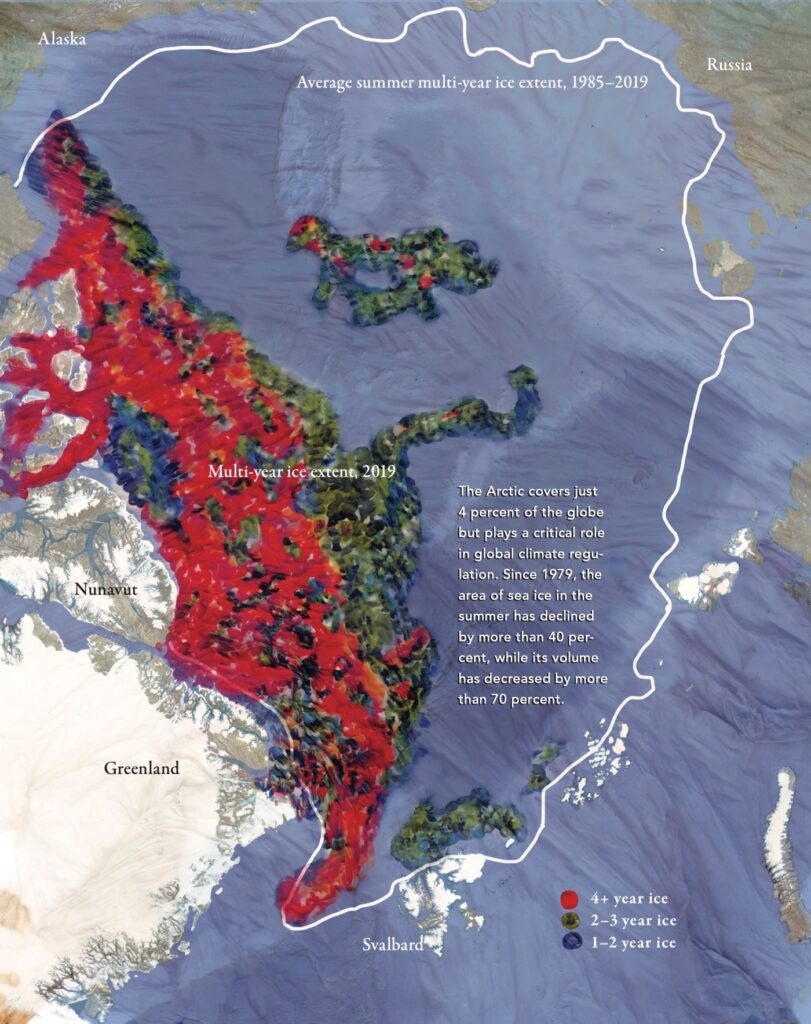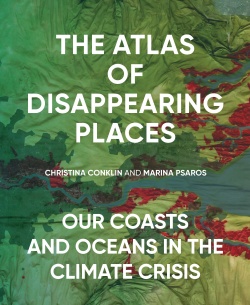The Present and (Possible) Future Arctic

Sea ice first forms as tiny, cellophane-thin, star-shaped crystals that spread across the water on calm, cold nights and merge into a fragile shell on the sea. Wind and waves break the surface into shards that recombine, forming a kind of slush called frazil or “grease ice.” As freezing temperatures bind loose pieces of frazil into larger sheets, the lumps of ice bump and jostle against each other, rounding their sharp edges into thicker ovoid forms called pancake ice. Sea ice can grow up to 20 centimeters (8 inches) thick above the surface, at which point it continues to grow from below the surface, reaching a depth of up to 1.5 meters (5 feet), with longer columns stretching far deeper. This first-year ice is the foundation of the Arctic system, accumulating across the northern ocean every winter to form a polar ice cap that is constantly fracturing and reconfiguring, always on the move.
If sea ice stays frozen for two years or more, it is called multiyear ice, and it can grow up to 5 meters (16 feet) thick, spreading to the horizon in every direction. Multiyear ice is critical to the Arctic ecosystem because it forms the cooling lid that prevents the ocean from warming too much each summer and over time. Without it, the planet’s air conditioning system would fail for half the year, allowing the global climate to fluctuate far more dramatically. But the Arctic air and sea are heating faster than any other region of the planet: 2019 was the second-warmest year on record, with sea temperatures up to 4°C (7.2°F) warmer than usual, and 2020 had the second-lowest sea ice minimum on record. The 13 lowest sea-ice extents have all occurred within the past 13 years. Ice loss from Greenland has nearly doubled each decade since the 1990s. And ice more than four years old, which once covered the entire polar sea, appearing like a great white continent, now mostly clings to the perimeter of the Arctic Basin. We have not been here before. The last time the Arctic Ocean was blue in the summer months was between three and four million years ago.
Encircled by a necklace of eight countries—Canada, the United States, Denmark (through Greenland), Russia, Sweden, Finland, Iceland, and Norway—the Arctic is home to four million people, most in Russia, where several large Soviet cities were built as outposts for miners and oil and gas workers. A small number of Indigenous peoples, including the Yupik, Inuit, Nenet, Chukchi, Aleut, and Saami, also live in the region in hardy, historically nomadic communities. Because their traditional ecological knowledge is so intimately tied to the fast-changing land and sea, they are all struggling to keep their people, languages, and cultural traditions alive. They are especially bound to the sea ice, the essential landscape for hunting and fishing.

For thousands of years, North America’s Inuit people have survived in the harsh and unpredictable Arctic climate. When, spurred by World War II and the Cold War, the Canadian government decided to secure its northern boundary, it forcibly moved almost all Inuit families from their nomadic camps into permanent settlements far from the good hunting sites. Many starved. Throughout the 1950s, ’60s, and ’70s, Inuit communities were overwhelmed by poverty, unemployment, diseases like mumps, polio, measles, and alcoholism, and the removal of one-quarter of all children to distant boarding schools. This intergenerational trauma lives on in Inuit and many other Indigenous communities as high rates of depression, suicide, and addiction. Only 65,000 Inuit remain in Canada. Sixty percent live in Nunavut, their ancestral northern homeland, but only half of those speak Inuktitut, the language that uniquely encapsulates their way of life.
Then, starting in the 1970s, people noticed that the weather was uggianaqtuq, behaving strangely. Winds blew stronger in the fall, preventing snow from accumulating and making it more difficult to build traditional iglu shelters on hunting trips for caribou, whale, and seal. River flow decreased, but when it rained, it rained harder. Spring came earlier almost every year, and summers were hotter. Sea ice became increasingly unsafe to travel across, so people became even more dependent on expensive, imported food.
Now, “virtually every community across the North is struggling to cope with extreme coastal erosion, thawing permafrost, and rapid destructive runoff,” according to Inuit activist Sheila Watt-Cloutier. “Sea ice remains in rapid decline. Glacial melt, long relied on for drinking water, is now unpredictable. … The change is not just coming, it is already here.” Hunting still provides half of peoples’ food in Nunavut, so 57 percent of local children currently live in food-insecure homes. Inuit leaders’ main concern now is food security. Cultural security is their second priority, the loss of which has led to extremely high rates of addiction, depression, and suicide.
Out of sight, the Arctic crisis feels distant to most people. But it is already affecting the global climate in several ways. Albedo, a measure of the reflectivity of various surfaces, is historically high in the Arctic because fresh snow reflects 80 to 90 percent of the sun’s light and heat back into space. But ice reflects only half as much sunlight as snow, land even less, and open water absorbs almost all of the heat that reaches it. When more snow melts, it reveals more land or sea, which then absorbs more heat, and the cycle amplifies itself in what is termed a positive feedback loop—a series of events that continually reinforce each other. Thus, Arctic amplication, as it is known, is transforming a vast region of the planet from a heat-reflecting shield into a heat-absorbing sink. Leading Arctic researcher Peter Wadhams says the ice-albedo feedback loop appears to be approaching its tipping point, which will lead to the largest single-cause increase in global temperature, a rise of .6°C (1°F).
Another critical feedback loop is the melting of frozen land. Permafrost—land that is frozen year-round with an uppermost “active layer” that melts seasonally—covers half of Russia, all of northern Canada, and most of Alaska with landscapes of musky green mosses and stubborn tufty grasses that cling to wet patches of rock. When the active layer melts each summer, its bacterial biome awakens and begins digesting the nutrient-rich soil, releasing both carbon dioxide and methane as waste. Since the 1980s, Arctic permafrost has warmed by 2 to 3°C (4 to 7°F), leading to significantly higher greenhouse gas emissions. By IPCC estimates, 69 percent (+/- 20 percent) of permafrost will melt by the end of the century, 84 times more potent than carbon dioxide over a 20-year time frame. If released in a short time span by sudden warming, underwater methane releases could quickly bounce the average global temperature up by another 0.6°C (1°F), with catastrophic consequences. But little methane research and almost no monitoring is being done.
Other positive feedbacks pulsing through the Arctic include increased wave energy, which breaks up more ice faster; increased water evaporation, which acts as a heat-trapping greenhouse gas; and water pooling on melted ice, which causes the underlying ice to melt even faster. “We are not far from the moment when the feedbacks themselves will be driving the change, that is, we will not need to add CO2 to the atmosphere at all, but will get the warming anyway,” warns Wadhams.
We do not know if these things are certain to happen, because the data is relatively sparse, but as Gavin Schmidt, a NASA climate scientist, notes, “ The planet is very capable of surprising us.” But as measured observations accumulate, many scientists have revised their most recent projections: the Arctic could be ice-free in September in little more than a decade, and throughout the summer by the mid-2030s.
A View from 2050
Ever since the Swedish scientist Svante Arrhenius first identified the “greenhouse gas effect” in 1908, northern countries have been eyeing the advantages of a warming Arctic. By 2020, Russia was using its fleet of icebreakers to guide freighters across its Northern Sea Route, where multiyear ice had become rare. China was investing heavily in Russian gas projects to secure both future energy supplies and a faster route to European markets, while many nations with nominal claims, from the United Kingdom to India, were jockeying for position in the region. Russia, Canada, and Denmark had applied to have part or all of the Lomonosov Ridge—the shallow underwater mountains that bisect the entire Arctic Ocean—added to their continental shelf territorial claims, along with all the associated drilling rights. With an estimated 30 percent of the world’s undiscovered oil and gas under the melting ice cap, a balance of geopolitical power as delicate as the Arctic ecosystem blanketed the region. The ice was melting so fast, and there was so much money to be made. Military and mining operations grew tense and sometimes confrontational in the 2020s, yet Arctic countries refused to develop any binding agreements for fear of limiting their own claims. The Northwest Passage, the holy grail of sea exploration along the Canadian and Alaskan coast, became a reliable shipping route, bringing significant income ashore in Iqaluit, the capital of Nunavut. Canada’s main planning document, the Arctic Policy Framework, was soon hopelessly out of touch with climatic and cultural realities, and Indigenous communities used the phrase “genocide by bureaucracy” to describe Ottawa’s inaction as summer temperatures surged. Eventually, the government of Nunavut negotiated the right to draft the region’s next policy plan. Arctic 2050 addressed the need for greater income and independence with a stiff tourist tax that would be reinvested in a “blue economy”of biofuel farms, wind energy, and tourist amenities to increase the region’s self-sufficiency. “Feedback” became the word of the decade, as people below the Arctic Circle began to understand that they needed to flatten the curve of climate change before the changes overtook them.
For the first time, in 2032, photos from space showed a blue ocean where the white polar ice cap had been for millions of years.
That same year, a multinational collaboration of scientists working in Svalbard—the icy archipelago near the North Pole—launched satellites to pinpoint and measure permafrost methane releases. A Norwegian university developed technologies that safely burned the methane into carbon dioxide, rendering it far less potent, and began converting floating natural gas facilities into emergency methane response bases that could be towed to the worst-emitting sites. Russia and China preferred to harvest methane as part of their national energy strategies. Drilling continued in the United States and Canada too, so by 2040 carbon dioxide levels passed 600 parts per million, the high end of the IPCC’s predicted range and double the pre-industrial level.
Equally tragic, in 2042, the largest oil spill in history washed a billion gallons of crude from floating Russian oil platforms into Nunavut’s territorial waters. Stuck beneath the winter sea ice, the black goo traveled deep into the Arctic gyre, killing thousands of birds and marine mammals and destroying most of the thick algal mats underneath the sea ice that form the base of the Arctic food chain. It took years and billions of dollars to remediate, though the algae and animals never really recovered.
Following the catastrophe, Indigenous activists and their allies demanded a new Convention on Indigenous Rights, which gave the First Nations, Metis, and Inuit peoples the right to review and veto all new mining and drilling projects that could potentially pollute treaty lands. Upheld by Canada’s Supreme Court, which had a history of reafirming the federal government’s treaty obligations, the victory rang somewhat hollow given the scale of environmental devastation. The Inuit immediately passed a moratorium on all future fossil fuel exploration in Nunavut, both on and off shore.

Indigenous leaders in Canada and around the world had been coming together for decades to strategize and support each other. As it became clear to leaders in Ottawa that the income from fossil fuels in Nunavut would never justify the costs of supporting the remote territory, some members of the opposition party began to quietly encourage Inuit calls for independence. The 2044 election swept in the opposition party on a reform agenda and, as promised, the new government moved forward on negotiating Nunavut’s independence, terminating both the 1999 Land Claims Agreement and Canadian sovereignty. It proved to be the first of many such formal decolonizations around the globe, all brought on by the escalating costs of climate adaptation. Now, in 2050, the Inuit find themselves living in an utterly altered ecosystem with little more in material terms than they had 200 years ago. But at least their homeland is their own.
© Christina Conklin and Marina Psaros. This excerpt originally appeared in The Atlas of Disappearing Places: Our Coasts and Oceans in the Climate Crisis, published by The New Press. Reprinted here with permission.
|
Christina Conklin
is an artist, writer, and researcher whose work investigates impermanence and possibility, often using the ocean as both site and metaphor. Her essays, exhibitions, events, and interactive installations consider our personal and societal responses to the intersecting global crises of our time. She is currently working with thought leaders and activists to grow emergent, regenerative systems in the San Francisco Bay Area and beyond.
|
|
Marina Psaros
is a sustainability expert and has led climate action programs across public, private, and nonprofit organizations for over a decade. She is one of the creators of the King Tides Project, an international community science and education initiative. An amateur cartographer and ocean advocate, she lives in the San Francisco Bay Area.
|







